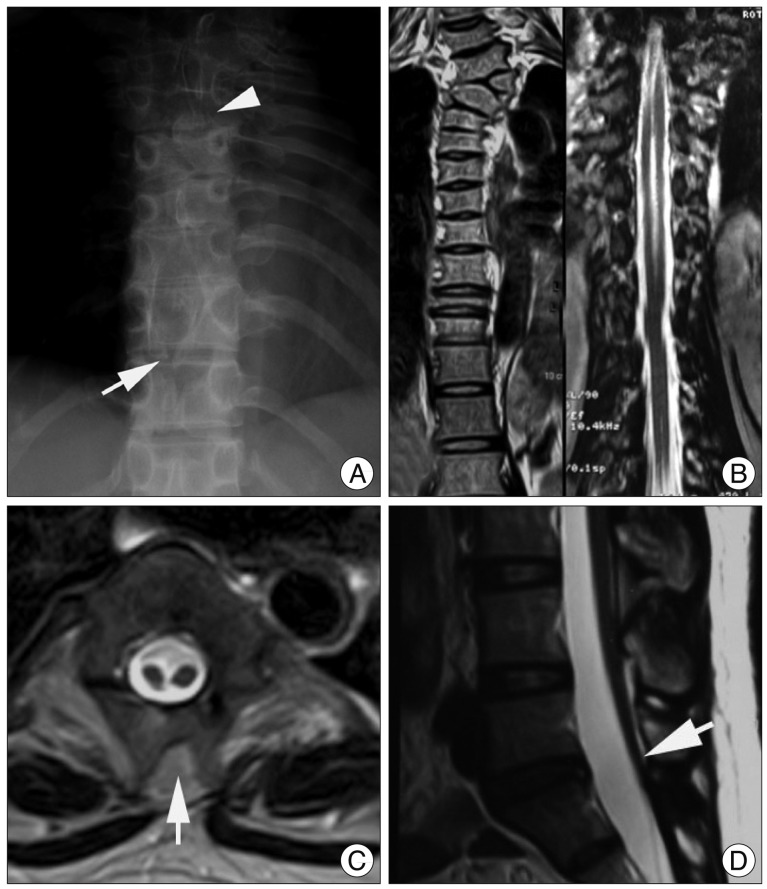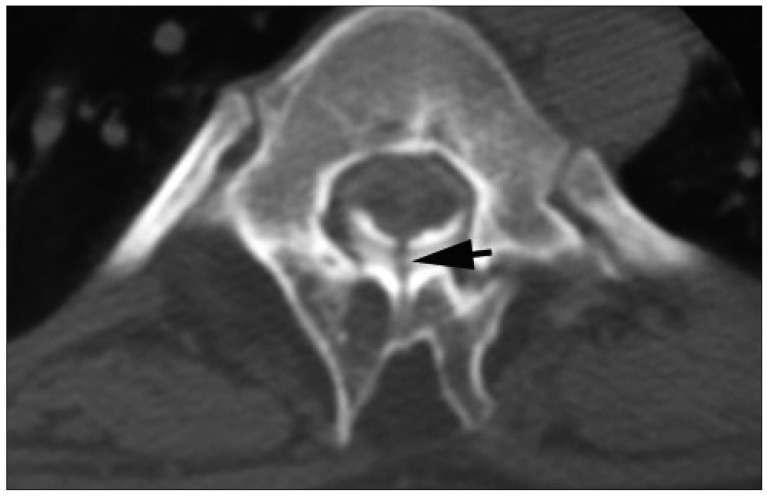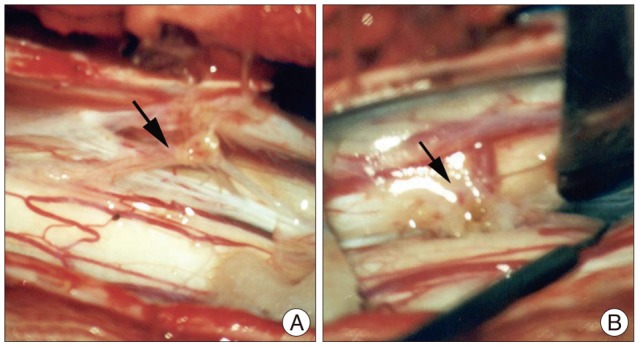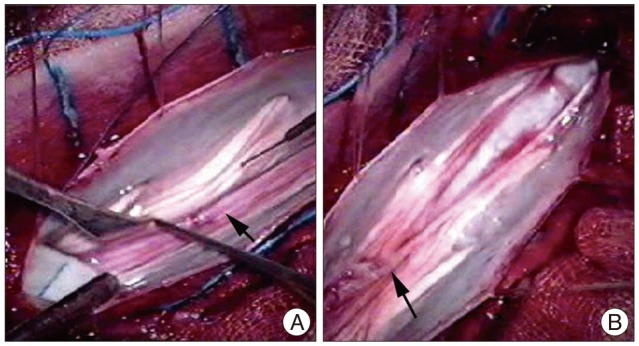J Korean Neurosurg Soc.
2013 Oct;54(4):363-365. 10.3340/jkns.2013.54.4.363.
Split Cord Malformation Combined with Tethered Cord Syndrome in an Adult
- Affiliations
-
- 1Department of Neurosurgery, St. Vincent's Hospital, College of Medicine, The Catholic University of Korea, Suwon, Korea. jatagi15@gmail.com
- KMID: 1499347
- DOI: http://doi.org/10.3340/jkns.2013.54.4.363
Abstract
- Split cord malformations (SCMs) usually present in childhood, and are rarely reported in adults. And also, a cervicothoracic SCM associated with tethered cord syndrome has very rarely been reported in the literature. We report a case of SCM associated with tethered cord and spina bifida in an adult. This report describes the case of a 34-year-old woman who presented for evaluation of neck pain, back pain, and intermittent paraparesis of several months duration. The MRI and CT showed a SCM at the cervicothoracic level and a fibrous septum at the thoracic level. She underwent surgery for the SCM and tethered cord syndrome, and was followed for 7 years. Patient presented complete recovery in the follow-up. The authors discuss this unusual lesion and describe the anatomical relationship of the level of cord duplication and fibrous septum.
MeSH Terms
Figure
Reference
-
1. Akay KM, Izci Y, Baysefer A, Timurkaynak E. Split cord malformation in adults. Neurosurg Rev. 2004; 27:99–105. PMID: 14618409.
Article2. Anderson RC, Ragel BT, Mocco J, Bohman LE, Brockmeyer DL. Selection of a rigid internal fixation construct for stabilization at the craniovertebral junction in pediatric patients. J Neurosurg. 2007; 107:36–42. PMID: 17644919.
Article3. Andro C, Pecquery R, De Vries P, Forlodou P, Fenoll B. Split cervical spinal cord malformation and vertebral dysgenesis. Orthop Traumatol Surg Res. 2009; 95:547–550. PMID: 19837020.
Article4. Chehrazi B, Haldeman S. Adult onset of tethered spinal cord syndrome due to fibrous diastematomyelia : case report. Neurosurgery. 1985; 16:681–685. PMID: 3889701.
Article5. Dias MS, Pang D. Split cord malformations. Neurosurg Clin N Am. 1995; 6:339–358. PMID: 7620358.
Article6. Guilloton L, Allary M, Jacquin O, Billaud Y, Drouet A, Felten D, et al. [Split-cord malformation (diastematolmyelia) presenting in two adults case report and a review of the literature]. Rev Neurol (Paris). 2004; 160:1180–1186. PMID: 15602364.7. Hertzler DA 2nd, DePowell JJ, Stevenson CB, Mangano FT. Tethered cord syndrome : a review of the literature from embryology to adult presentation. Neurosurg Focus. 2010; 29:E1. PMID: 20593997.8. Jindal A, Mahapatra AK. Split cord malformations--a clinical study of 48 cases. Indian Pediatr. 2000; 37:603–607. PMID: 10869139.9. Kaminker R, Fabry J, Midha R, Finkelstein JA. Split cord malformation with diastematomyelia presenting as neurogenic claudication in an adult : a case report. Spine (Phila Pa 1976). 2000; 25:2269–2271. PMID: 10973414.
Article10. Lapsiwala SB, Iskandar BJ. The tethered cord syndrome in adults with spina bifida occulta. Neurol Res. 2004; 26:735–740. PMID: 15494114.
Article11. Lewandrowski KU, Rachlin JR, Glazer PA. Diastematomyelia presenting as progressive weakness in an adult after spinal fusion for adolescent idiopathic scoliosis. Spine J. 2004; 4:116–119. PMID: 14749200.
Article12. Mahapatra AK, Gupta DK. Split cord malformations: a clinical study of 254 patients and a proposal for a new clinical-imaging classification. J Neurosurg. 2005; 103:531–536. PMID: 16383252.
Article13. Muroi A, Fleming KL, McComb JG. Split medulla in association with multiple closed neural tube defects. Childs Nerv Syst. 2010; 26:967–971. PMID: 20179945.
Article14. Ozturk E, Sonmez G, Mutlu H, Sildiroglu HO, Velioglu M, Basekim CC, et al. Split-cord malformation and accompanying anomalies. J Neuroradiol. 2008; 35:150–156. PMID: 18206241.
Article15. Pallatroni HF, Ball PA, Duhaime AC. Split cord malformation as a cause of tethered cord syndrome in a 78-year-old female. Pediatr Neurosurg. 2004; 40:80–83. PMID: 15292638.
Article16. Pang D. Split cord malformation : Part II : Clinical syndrome. Neurosurgery. 1992; 31:481–500. PMID: 1407429.17. Pang D, Dias MS, Ahab-Barmada M. Split cord malformation : Part I : A unified theory of embryogenesis for double spinal cord malformations. Neurosurgery. 1992; 31:451–480. PMID: 1407428.18. Peart O. Split cord malformation. Radiol Technol. 2004; 76:168. PMID: 15587620.19. Sato K, Yoshida Y, Shirane R, Yoshimoto T. A split cord malformation with paresis of the unilateral lower limb : case report. Surg Neurol. 2002; 58:406–409. discussion 409. PMID: 12517623.
Article20. Sharma A. Split cord malformations. Indian Pediatr. 2001; 38:1069–1070. PMID: 11568396.
- Full Text Links
- Actions
-
Cited
- CITED
-
- Close
- Share
- Similar articles
-
- Sacrococcygeal Teratoma with Split Spinal Cord Malformation
- Nerve injury in an undiagnosed adult tethered cord syndrome patients following spinal anesthesia: A case report
- Tethered Cord Syndrome in Spina Bifida Occulta: A Case Report
- A Case of Enuresis and Renal Failure by Tethered Cord Syndrome with Sacral Lipoma
- Neurogenic Bladder in the Patients with Tethered Cord Syndrome: A case report





